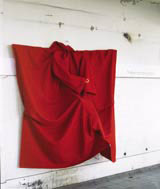Observational humour
Anne Celine Jaeger talks to Thélermont Hupton, a dynamic duo that creates products to suit our changing lifestyles

Even if you’d never met them, you’d figure out pretty sharpish that Yve Thélermont and David Hupton are a team. Not only do they both turn up to the interview wearing stripes (completely unintentionally), but they also have a tendency to finish each other’s sentences.
From the moment they met on the furniture design course at London Metropolitan University five years ago, both knew they wanted to collaborate. Thélermont says, ‘I always knew I wanted to work with somebody else, so we just decided we’d try collaborating on a couple of projects and take it from there.’ Fast-forward a couple of years and, 12 months after graduating, the duo already has the New Designers, Designersblock and Salone Satellite exhibitions under its belt. And, thanks to the Crafts Council bursary, without which they wouldn’t have been able to afford a stand, they will be celebrating the group’s first anniversary at 100% Design.
The company may only be a year old, but it is already clear that Thélermont Hupton has a signature style. Whether it’s the Sway stools (colourful, swaying stools that provide flexible alternatives to chairs) or the Not At The Table range (crockery that can be used to eat around the house – for instance, mugs for balancing on the knee), all of the duo’s creations have an element of humour in them, derived from linking the body to the object. Hupton says, ‘We don’t set out to be quirky and humorous, but often we come up with things that make us smile and we think to ourselves, “that would be funny, let’s see whether people will like it”. Generally, we want people to physically engage with the objects and connect with them, and humour is derived from that.’
Inspired by the likes of Dutch designer Hella Jongerius, who fuses craftsmanship with industrialisation to create pieces such as her embroidered ceramic vases, and the Monkey Boys, who play with materials to come up with unpredictable designs such as the molten couch, Thélermont Hupton’s designs have a tendency to emerge from experimental ideas based upon observation and the changing patterns of everyday living. Often, the duo will start with a theme, ritual or story and expand from there. However, whatever the group works on, it always consults a plethora of people before putting pen to paper or plasticine to hand, to canvass views on a particular aspect of day-to-day living.
‘Take the Sway stools for example,’ says Thélermont. ‘Those came about by looking at small spaces, talking to people and finding out what it means for their lifestyle to be restricted by the space they live in. By being small seats, which you can pull out whenever you have guests, they form part of a solution.’ Thélermont Hupton’s approach was not dissimilar for its Not At The Table crockery.
‘This idea came about after looking at the changing patterns of eating,’ suggests Hupton. ‘More and more people are moving away from formal dining and are eating around the house, in front of the TV or in bed. So we’ve come up with various solutions such as a concave mug for resting on your knee and a serving tray you can put your thumb through, which is [also] ideal for parties.’
Interestingly, Thélermont Hupton’s fascination with getting other people involved doesn’t stop at the design level. Were it not for the group’s collaborative spirit, Sway and Not At The Table might have ended up quite differently. As it was, the Sway prototype was finally crafted out of fibreglass, not because that was the intention, but because a New Buckenham local (where Hupton hails from) was kind enough to show him how to work in that material. Likewise, the Not At The Table prototypes were made from white earthenware because the stoneware specialist they drafted was willing to experiment in, what was for him, a new material. Hupton says, ‘We have a tendency to link with people who are interested in what we’re doing and interested in doing something different. It doesn’t matter at what level. The man at the local garage, for example, is extremely helpful. When he walks his dog, I walk with him and we talk about technical issues.’
Clearly not afraid to experiment with new ideas or even people, it comes as no surprise to learn that Thélermont Hupton’s next project will involve working with materials that are little known to them – such as ceramics and resin. ‘Finding the right material, which is affordable and also evokes the right message is important to us,’ says Thélermont. Judging by its recent successes, this design duo will have no trouble discovering that perfect balance.
-
Post a comment




